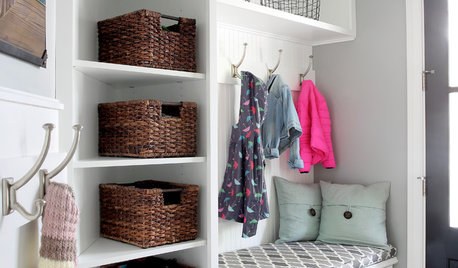Please help me! Need to rip out and start over!
Becca_303
9 years ago
Related Stories

DECORATING GUIDESHow to Decorate When You're Starting Out or Starting Over
No need to feel overwhelmed. Our step-by-step decorating guide can help you put together a home look you'll love
Full Story
GARDENING FOR BUTTERFLIESA Quick-Start Guide to Bird-Watching for Fun and Learning
Set out some seed and grab your field guide. Bird-watching is an easy, entertaining and educational activity for the whole family
Full Story
HOME OFFICESQuiet, Please! How to Cut Noise Pollution at Home
Leaf blowers, trucks or noisy neighbors driving you berserk? These sound-reduction strategies can help you hush things up
Full Story
INSIDE HOUZZInside Houzz: Starting From Scratch in a Manhattan Apartment
Even no silverware was no sweat for a Houzz pro designer, who helped a globe-trotting consultant get a fresh design start
Full Story
MOST POPULAR10 Things to Ask Your Contractor Before You Start Your Project
Ask these questions before signing with a contractor for better communication and fewer surprises along the way
Full Story
MOST POPULAROrganized From the Start: 8 Smart Systems for Your New House
Establishing order at the outset will help prevent clutter from getting its foot in the door
Full Story
ARCHITECTUREDesign Practice: How to Start Your Architecture Business
Pro to pro: Get your architecture or design practice out of your daydreams and into reality with these initial moves
Full Story
HOUZZ TOURSHouzz Tour: New Love and a Fresh Start in a Midcentury Ranch House
A Nashville couple, both interior designers, fall for a neglected 1960 home. Their renovation story has a happy ending
Full Story








morpheuspa (6B/7A, E. PA)
morpheuspa (6B/7A, E. PA)
Related Professionals
Allen Landscape Architects & Landscape Designers · Oatfield Landscape Architects & Landscape Designers · Springfield Landscape Contractors · Broomfield Landscape Contractors · Deerfield Beach Landscape Contractors · Garland Landscape Contractors · Marlborough Landscape Contractors · Mesa Landscape Contractors · Oak Forest Landscape Contractors · Secaucus Landscape Contractors · Wanaque Landscape Contractors · Eastvale Swimming Pool Builders · Goodlettsville Swimming Pool Builders · Malden Swimming Pool Builders · Randolph Swimming Pool Buildersdchall_san_antonio
Becca_303Original Author
dchall_san_antonio
lazy_gardens
morpheuspa (6B/7A, E. PA)
Becca_303Original Author
dchall_san_antonio
dchall_san_antonio
morpheuspa (6B/7A, E. PA)
dchall_san_antonio